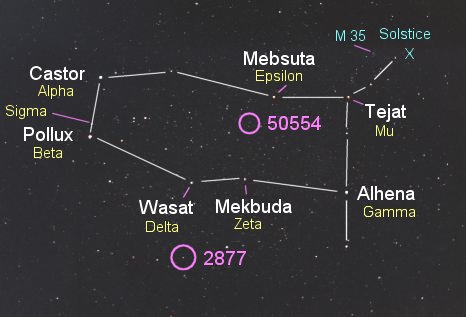 Like HR 2447, the system is unusual in
that the planet belongs not to an ordinary dwarf, as most do, but
to a giant star, one that is in the act of evolving and dying.
Like HR 2447, the system is unusual in
that the planet belongs not to an ordinary dwarf, as most do, but
to a giant star, one that is in the act of evolving and dying.
THE PLANET
The lower circle shows the location of the class K giant star HR
2877, found in the constellation Gemini.
The planet, with a mass estimated to be at least 6.5 times that of
Jupiter, orbits its star with a period of 303 days at an average
distance of roughly 0.8 Astronomical Units (120 million kilometers,
75 million miles, 10 percent greater than the size of Venus's
orbit). The orbital eccentricity is not known. The parameters of
giant-star planets are not well constrained, as they first require
an estimate of stellar mass. Ordinary dwarfs have luminosities and
temperatures that are very sensitive to mass, and it is therefore
easy to obtain it and thus to find the needed values from the
velocity data. The luminosities and masses of giants, however, are
nowhere near as sensitive to mass, which yields larger errors in
the results.
|
 Like HR 2447, the system is unusual in
that the planet belongs not to an ordinary dwarf, as most do, but
to a giant star, one that is in the act of evolving and dying.
Like HR 2447, the system is unusual in
that the planet belongs not to an ordinary dwarf, as most do, but
to a giant star, one that is in the act of evolving and dying.
 Like HR 2447, the system is unusual in
that the planet belongs not to an ordinary dwarf, as most do, but
to a giant star, one that is in the act of evolving and dying.
Like HR 2447, the system is unusual in
that the planet belongs not to an ordinary dwarf, as most do, but
to a giant star, one that is in the act of evolving and dying.